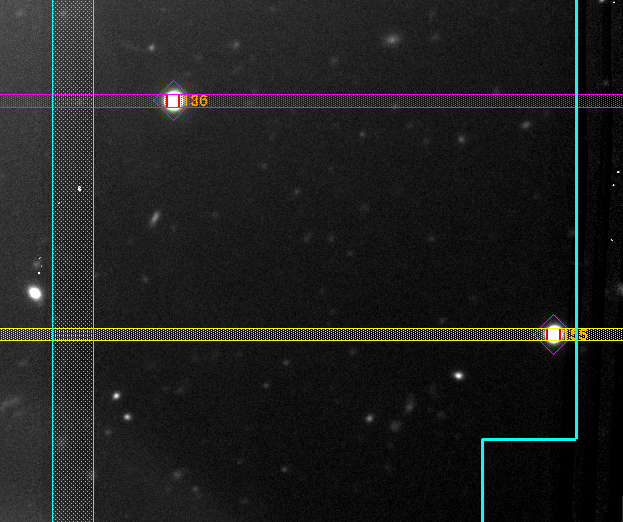14. Appendix: Acquisition stars¶
MOS masks are acquired by centering at least two acquisitions stars in reference slits (2x2 arcsec square boxes). To this end, the centroids of the reference slit and of the star are measured.
A list of requirements and recommendations is given below.
14.1. Requirements¶
How many stars: At least two (recommended: three) acquisition stars are required if the mask was designed based on pre-imaging data. If the mask was designed using external catalogs and pseudo-images, then at least three (recommended: four) acquisition stars are required. More stars will increase the overhead unnecessarily.
Same astrometric reference system: It is paramount that acquisition stars and science targets are taken from the same catalog or data source.
Must not saturate in pre-image: If saturated in the pre-image, then the centroids of the acquisition stars are uncertain, and the acquisition will likely fail.
No proper motion stars: Do not use high proper motion stars, as the pre-images and the actual science observations may be taken months or years apart. GMMPS checks the proper motion vectors.
Where on the detector: Acquisition stars should be placed as far from each other as possible, and ideally in a triangular fashion.
Stay clear of detector gaps and field border: GMMPS issues a warning if an acquisition star is less than 4.0” from a detector gap or the border of the slit placement area. An additional acquisition star must be included in the mask design as backup unless there are already 2 (pre-image) or 3 (pseudo-image) good acquisition stars present. Distances less than 2.0” are not permitted by GMMPS because the centroid measurements will likely fail due to truncation and / or shadowing. In this case, the star’s priority must be changed to a non-zero value.
No OIWFS guide stars: OIWFS guide stars are shadowed by the guide probe arm. They cannot be used as acquisition stars.
14.2. Recommendations¶
Stars, not galaxies: Stars should always be preferred over galaxies as they have better defined centroids, and the centroid is independent of the light distribution as a function of seeing. This is not the case for galaxies, where substructures may bias the centroiding. Galaxies may be used as a last ressort, only, e.g. if insufficient guide stars are available. In that case, choose featureless galaxies with compact bright nuclei.
Bright enough: Acquisition stars should be bright enough (between mag 12-19) and ideally within 2 magnitudes (so that they can be displayed properly in a single exposure by the observer). Fainter stars may be used if necessary, but this will increase the overheads as the observer possibly needs to increase the exposure times.
If in doubt: If you are not certain about a particular acquisition source, for whatever reason (e.g. close to gap, possibly proper motion), an additional acquisition star must be provided.
Note
The rms offset of the acquisition stars from the center of the acquisition boxes must be less than 25% of the slit width of the narrowest science slit. Otherwise the observing software decides that the mask cannot be aligned.

Fig. 14.1 The acquisition star to the lower right is within 4.0” of the border of the slit placement area. Most likely this is ok, but its spectrum is shown yellow to highlight it as potentially problematic. An additional acquisition star must be included in the mask design unless there are already 2 (pre-image) or 3 (pseudo-image) good acquisition stars present. The acquisition star to the upper left has a safe distance to the GMOS detector gap.¶
